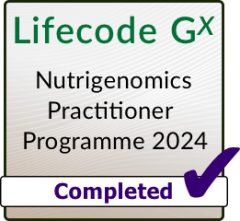A loaf for all the family
| Recipe By: | Dr Nikki Swan |
|---|---|
| Recipe Status: | Untested |
| Kind of Bake: | Ambient overnight – 10-minute style – mixed in the evening and baked in the morning |
| Makes: | 2 x 2lb tin loaves |
| Created Over: | 2 days |
| Recommended For: |
|
| Diversity Score: | 23 |
|---|---|
| Increase Fibre: | The proposed recipe is more than just a tin loaf. It is about a flour blend and some suggested inclusions. The tin loaf incorporates all of the ingredients, but the flour blend itself can become the ‘go to’ flour for many different bread recipes for example, pocket breads, pizza dough or pasta dough from Dr Vanessa Kimble’s “10-Minute Sourdough Book”. The primary ingredients can be used instead of blend 0, 1 or 2 in these recipes. I suggest putting the baobab powder into the flour mix as well to boost the fibre. Whilst it is not a UK grown ingredient, it is available through Fair Trade organisations and therefore contributes to farmers in some less economically well-off countries. It has 10 times the amount of vitamin C than an orange has in just 100g so in 10g it contains the same amount as an orange. Every 10g of baobab powder has between 4 and 5.5g of soluble fibre; 30mg calcium, 200-220mg Potassium, 15mg magnesium, 0.2-0.5mg iron, high levels of polyphenols and is very low fat and low sugar. The soluble fibre content itself helps with blood sugar regulation and cholesterol control as well as being a prebiotic food for the good bacteria in the gut. Included in the flour are teff seeds. Teff is a pseudograin primarily produced and used as a staple in Ethiopia. Because of the small size of teff it is made into wholegrain flour resulting in very high fibre content (7-9.8%) and high nutrient content in general (Gerremariam et al, 2012). It contains all 9 essential amino acids required by humans particularly lysine, as well as polyphenols, key minerals (bioavailable iron, calcium, magnesium, zinc, phosphorus and copper), vitamins in the B range (riboflavin, niacin, thiamine), vitamin C and is gluten free. |
| Probiotic Serving Suggestion: | Serve with Kimchi or sauerkraut in a sandwich filling such as: a chickpea, avocado smash with a good squeeze of lemon juice and a tsp of mustard or tahini, (maybe adding salt and pepper, cumin or smoked paprika) with a topping of red onion, grated carrot or chopped celery. Add some fresh spinach leaves, tomato slices and or cucumber for moisture and place on the vegan sourdough bread. Serve with the sauerkraut or kimchi. |
| Antioxidants: | This loaf delivers the following antioxidants: • Polyphenols: From grains, seeds, legumes, and flowers giving broad-spectrum antioxidant protection • Carotenoids & Anthocyanins: For eye health, vascular integrity, and anti-inflammatory effects • Lignans & Flavonoids: Hormonal balance, cardiovascular support, and cellular repair • Vitamin E, C, and Selenium: Core antioxidant nutrients that neutralize free radicals and support immune resilience The fermentation process in sourdough further enhances antioxidant bioavailability by breaking down phytates and increasing microbial synthesis of B vitamins and organic acids . |
| Suggested Botanical Blend: | I created my own Botanical Blend |
Ingredients
| Ingredients | Quantity |
|---|---|
| Nikkis botanical blend | 500g |
| Marriages bread flour | 500g |
| Salt | 20g |
| White starter | 200g |
| Water | 750g |
| mixed seeds: pumpkin sunflower poppy (red and black) black sesame brown linseed chia hemp and teff | 12.5g of each |
| Baobab powder | 10g |
| Nutritional yeast fortified with vitamin B12 | 12g |
Botanical Blend by Dr Nikki Swan
| Ingredients | Quantity |
|---|---|
| Wholegrain spelt | 350g |
| wholegrain Einkorn | 350g |
| Wholegrain rye | 50g |
| chickpea (whole if milling yourself or flour) | 50g |
| Red quinoa | 25g |
| Black quinoa | 25g |
| naked oats (or oat flour) | 20g |
| Black barley | 20g |
| millet | 10g |
| Teff seeds (or flour) | 50g |
| nettles | 2g |
| cornflowers | 1g |
| mallow flowers | 1g |
| hibiscus flowers | 1g |
| nori seaweed flakes | 1g |
| Dried shitake mushrooms | 1g |
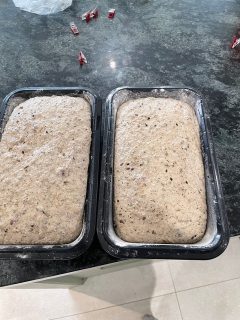
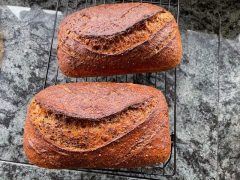
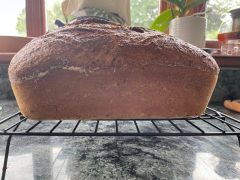
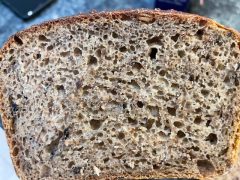
Recipe Introduction
This recipe has a full PDF you can download to read more about the recipe.
This is really about the flour and inclusions and whilst a simple tin loaf is given below, it can be used for ambient or retarded tin loaves; boules, pizza dough, focaccia, or many other recipes. Attached ‘here’ is a link to the other versions of this loaf. This loaf was developed after exploring the nutritional challenges and opportunities within plant-based and vegan diets, particularly focusing on how to address common deficiencies through personalised baking. Drawing from my personal experience; friends asking what to do when a child announces they have gone plant based but are fussy eaters; and research, the attached paper highlights the importance of informed dietary planning when transitioning to a plant-based lifestyle—especially for individuals who adopt veganism abruptly and rely heavily on social media for (bad) guidance.
Key concerns with vegan diets are identified in the research and show that several nutrients are commonly deficient in poorly managed vegan diets:
• Vitamin B12: The most critical concern, as it is not naturally present in plant foods in bioavailable forms. Deficiency can lead to serious health issues, and supplementation or fortified foods (e.g., nutritional yeast, Marmite) are essential.
• Vitamin D, iodine, selenium, calcium, iron, and zinc: These are also flagged by the NHS as nutrients that may require fortification or supplementation.
• Essential amino acids: Particularly lysine, leucine, and valine, which are vital for muscle repair, immune function, and metabolic health. While total protein intake may be adequate, amino acid diversity can be lacking.
This bread uses the BALM protocol and personalised baking as a vehicle for delivering essential nutrients in a family-friendly format. This bake and the others in the attached version are designed to:
• Create nutrient-dense bread which includes a complete amino acid profiles
• Be rich in fibre, addressing the widespread shortfall in dietary fibre intake (only ~9% of UK adults meet the 30g/day recommendation) suitable for vegans and vegetarians that is easy to make and has a flavour profile that is not too ‘out there’!
• Incorporate seeds, pulses, and fortified ingredients to boost micronutrient density
• Avoid ultra-processed foods (UPFs), which are common in commercial vegan products
• Offer symbiotic recipes that complement the bakes for complete nutrition
• Provide “bonus bakes” using starter discard to reduce waste and promote sustainability
• Suggests local flours to support the farmers around me, which you can do too.
The attached paper critically evaluates both NHS guidance and academic literature and gives you more depth of information, whilst also countering some social media fiction, such as:
• NHS advice is helpful but sometimes outdated (e.g., “5-a-day” fruit and veg) and lacks nuance around UPFs and bioavailability.
• Studies show that while vegans often consume more fibre and antioxidants, they may fall short in key nutrients unless their diet is carefully managed.
• Research from Drs Tim Spector and Vanessa Kimble supports the benefits of dietary diversity and fibre-rich botanical flours.
• Case studies and systematic reviews reinforce the need for B12 supplementation and highlight variability in nutrient status among vegans, vegetarians, and omnivores.
Transitioning to a plant-based diet can be healthful and sustainable, but only with careful planning and evidence-based choices. Personalised baking and the BALM protocol offer a practical, inclusive way to support nutritional adequacy for individuals and families navigating dietary changes. The loaf advocates a “food-first” approach, minimizing reliance on supplements and UPFs, and emphasizes the importance of education, diversity, and whole foods in building a resilient, sustainable plant-based diet.
Studies
| Study | How this study has been applied |
|---|---|
| Read the Full PDF here | Read more |
| Vitamin D | A comprehensive overview of uses of Vitamin D |
| Vitamin Bs | A short but complete overview of the B vitamins and availability through fermentation |
| Antioxidants | A good overview of different antioxidants |
| B vitamins lecture Venetia Mitchell | Comprehensive lecture on B vitamins |
| Spelt | Understanding of the benefits of spelt grain |
| Einkorn | Understanding of the benefits of Einkorn |
| Rye | Understanding of the benefits of rye |
| Oats | Understanding of the benefits of oats |
| Barley | Understanding of the benefits of barley |
| Polyphenol rich lentils | Health benefits of lentils |
| Sunflower seeds | Health benefits of sunflower seeds |
| Poppy seeds | Health benefits of poppy seeds |
Equipment
- Large mixing bowl
- Scales
- Spatular
- 2 x 2LB (900g) Loaf Tins
- 2 show caps or other cover that wont stick to top of dough
Tin Size cm (HxWxD)
8.5 cm x 13 cm x 25cmStarter Quantity
200g
Status of Starter
bubbly, lively third-build starter
DDT
27°C (80°F)
Flours
- Nikki's botanical blend
- Marriages White roller milled or any strong white flour (13% protein or above)
- The white roller milled can be swapped out for a locally stoneground white (pref organic)
Baking Temperature
220°C/200°C fan/425°F/gas mark 7
Baking Time
45 minutes
Timings
| Step | Day | Timings (hh:mm) |
|---|---|---|
| Mix seeds with 100g boiling water and leave to cool | Day 1 | 8.00pm |
| Mix fresh milled Nikki blend and white flour together, add 2nd / 3rd build starter, salt and 675g water. | Day 1 | 8.30pm |
| Mix the baobab powder and nutritional yeast into the seeds thoroughly then add 50g water so it goes a bit sloppy and then bassinage into the flour mix | Day 1 | 9.00pm |
| Bassinage a further 50g water into mix | Day 1 | 9.30pm |
| Remove from bowl and use dough scraper to shape as if Pre-shaping. Get it as tight as you can and lower into the greased and floured tins (for vegan use coconut oil and flour). Cover and leave on the side in the kitchen. | Day 1 | 10.00pm |
| Cover with a shower cap or similar and place in a cold fridge (5-8C) | Day 1 | 10.15-10.30pm |
| Preheat oven to 230C with as much steam as you can generate | Day 2 | 8.00am |
| Score and place tins in oven turning it down to 200C but again keeping the max steam. Cook for approx. 45 mins | Day 2 | 8.15am |
| Cool and store wrapped in beeswax and will last 3-7 days. | Day 2 | 9.00am |
How to Store
Wrapped in beeswax it will last 3-7 days. Really moist on day 1 but still really good by day 3 but may need toasting by day 7
Top Tips
This loaf mix also works for a boule but may require more experience because nutritional yeast breaks down gluten, and because there are a lot of ingredients in the flour mix without gluten, once the nutritional yeast is added be very gentle with your stretch and folds (if doing a boule) as the gluten will break easily. Only do one, or max 2, S&F and do more bench work when doing your pre-shape instead. This is a hyperactive dough and although my kitchen tends to be rather warm, watch it carefully as it will move fast once it gets going!
Nutritional yeast can breaks down the gluten. This break down of gluten makes it hard to manage the dough if the hydration is too high. It is why I suggest a pre-shape even though this is a tin loaf. Without it you might get a flat top to your tin rather than a gentle dome but it wont affect the flavour. If the gluten is degraded by adding the nutritional yeast the tin will still hold the bread up. So basically don’t worry! The nutritional yeast is inert and will have no ‘rising’ effect on the bread, that is all in the fermentation so don’t reduce your starter in the mistaken view that you are adding a baking yeast – you are not. But this is a fast rising bread, especially if using stoneground white as well as the home milled flour blend. So by all means reduce the amount of starter if you want to slow the process down to fit your time schedule.
I have tried this recipe with several different white flours. Stoneground flours are very enzymic and the bread is easier to manage with roller-milled which means it has by law to be fortified. This can be problematic (please see my paper if you want to know why) but for many people they have never eaten anything other than fortified white flour. The recipe can be done with stoneground flour but is definitely not a beginners mix! Marriages Strong Bread Flour/ Waitrose Essential Bread Flour is very high protein at the moment (14.2%) and gives some extra stability. Potentially a Canadian could be substituted or you could add Vital Wheat Gluten (available from many baking suppliers) to enhance the protein % of another roller milled (follow the instructions for quantities). However if you can manage to use stoneground white flour then I use either Bruerns Flour (https://bruernfarms.co.uk/pages/our-flour) which is available at Ratton Pantry (http://rattonpantry.co.uk) or I use Stoates Organic Trues South West Flour (https://stoatesflour.co.uk/products/true-south-west-flour-25kg). Both of these are local to me. You can use your local miller.
If you don’t have a mill this flour blend can be made with using ready ground flours. All of the grains are available as flour (even teff) and whilst I would hope you can get them locally or through a reputable miller near you, if all else fails they are all available from the dreaded Amazon. I use dried nettles, flowers, seaweed and mushrooms and put them through my mill but you could put them in a coffee grinder for just sprinkle them in (in as small pieces as you can).
If you have never bought nutritional yeast before just be a little careful as not all varieties include vitamin B12, but if they do it is usually clearly displayed on the front of the packet! It is available in most supermarkets these days.
This bread mix browns very well. If you don’t like it as brown turn the oven down to 180 after 35mins and add an extra 5 mins to the total time. Alternatively just slip a piece of silver foil over the top of the tin when it is brown enough to prevent it going any further, just don’t do this too early where it can stick to the dough! Also, you can put the loaf in a cooling oven after the baking has finished, without the tin, to brown the inside edges of the loaves.
Sprouting some or all of the grains can also make them even more bio-available if you want to get adventurous, but the fermentation does a good job of this anyway.

